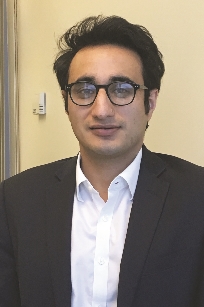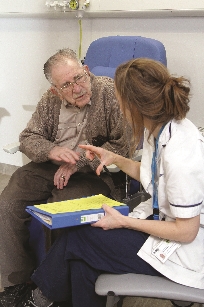Outpatients: a new look?

The NHS outpatients model is obsolete. So said NHS England chief executive Simon Stevens, addressing the NHS Confederation conference in June. The periodic trip to outpatients for five minutes with the consultant was unlikely to be delivering great value for anybody, he said. ‘Think of it from the patient’s point of view, think of it from the clinical team’s. Have the conversation of what redesign looks like,’ he said.
There certainly seems to be a growing consensus that this is an area ripe for reform, delivering more value by improving services and convenience for patients and potentially reducing costs or freeing up scarce resources. Elsewhere, the Getting it right first time initiative has launched a review of outpatient services under the lead of consultant ENT surgeon John Hadley.
Reforming the outpatients model is not a new idea. NHS Improvement chief executive Ian Dalton told the same NHS Confederation conference that the service had ‘been talking about modernising outpatients for a long time’. But it has clearly been stuck in the too difficult pile. And there now seems to be a real push to prioritise this particular modernisation.
It is a significant area of expenditure – Mr Stevens said spend was close to £10bn – and it is also a rapidly expanding activity.
According to national statistics, there were nearly 119 million outpatient appointments in 2016/17, of which 94 million were attended by patients. This attendance figure is up from 52 million in 2006/07. Patients aged 60-79 accounted for over 30% of all attendances and 31% (of all attendances) were first appointments, with GPs the source of referral for these in just over half of cases.
The sharp rise in outpatient attendances – rising faster than other types of healthcare activity – has lifted outpatient services up the transformation priority list. But while the model has stayed largely unchanged since the start of the NHS, there have been attempts to stem the rising activity.
 However, Sophie Castle-Clarke, senior fellow in health policy and digital programme lead at the Nuffield Trust, says these have not always been helpful.
However, Sophie Castle-Clarke, senior fellow in health policy and digital programme lead at the Nuffield Trust, says these have not always been helpful.
‘One activity that’s been used to reduce activity is to change GP referral behaviour – reviewing the appropriateness of referrals through referral management centres,’ she says.
This has involved either an administrative person or a clinician reviewing referral decisions against a set of guidelines before firming up the need to see a consultant.
‘This has been adopted quite rapidly, but there is limited published evidence to suggest it is effective at saving money or cutting inappropriate referrals,’ she says. ‘It often simply adds a delay to the process because of the additional review.’
She says such centres typically carry a large overhead that can outweigh any savings from reduced referrals. And she points at BMJ research that found just 10 out of 72 clinical commissioning groups with referral management schemes could demonstrate savings. Other initiatives have sought to transfer activities traditionally undertaken in outpatient departments to GPs.
But Ms Castle-Clarke says that, with primary care so massively stretched, asking GPs to do more is unlikely to be effective. Instead, she says, referral practice can be improved significantly by strengthening relationships and communication between GPs and consultants. ‘We need to remove the barriers preventing GPs asking consultants for advice – potentially in the presence of patients,’ she says.
One model already having success in this area has been pioneered by Imperial College Healthcare NHS Trust, where general practice-based child health hubs have been established as the central point for child health. The model was one of a number of new approaches spotlighted in a Nuffield Trust/NHS Improvement workshop at the end of 2017.
A hub typically brings together three or four GP practices covering a population of 20,000, with about 4,000 registered children. They are built around monthly multidisciplinary team meetings attended by hospital consultants to discuss paediatric cases. The consultants also hold outreach clinics with a hub GP.
The response has been positive, with patients feeling better supported and health practitioners also benefiting. GPs talk about learning from the joint clinics and meetings and being able to apply that learning in general consultations. They also have more confidence in talking to and contacting paediatricians.
With this collaborative approach, there has also been a reduction in traditional hospital activity. In one hub – comprising three GP practices – 39% of new patient appointments were avoided through the multidisciplinary team and improved care co-ordination. A further 42% of appointments were relocated from hospital to GP practices. There was also a 19% drop in subspecialty new patient appointments, with paediatric admissions down 17% and A&E attendees down 10%.
Imperial’s consultant paediatrician, Mando Watson, says the changes – part of a Connecting care for children programme – represent more of an adjustment to existing practice than a revolution. With a first hub in place five years ago, Imperial now supports seven hubs across its patch, covering a third of its resident population. Further hubs have been established across North West London and some areas outside London are in the early stages of establishing similar arrangements.
But while she is keen to expand the model further – within child health across the Imperial patch and beyond and more broadly where the model is relevant to other services – Dr Watson says a revised payment system would help. The current tariff system, with payments for first and follow-up outpatient attendances, does not fit well with the new community-based model.
A capitation model would be more appropriate, she says, admitting to frustration at the slow pace of change in payment reform nationally. ‘I’d love this to be scaled up quickly,’ she says. ‘In a cash-strapped NHS, when you have something that delivers this type of efficiency, we have a moral obligation to do it.’
Another key principle is to concentrate consultants’ time – the service’s most expensive resource – where it is most needed. In some examples, this has involved consultants supporting other practitioners in assessing or reviewing general patients, leaving consultants to see the most complex cases.
A new musculoskeletal service in Nottinghamshire relies on a consultant-supported but physiotherapy-led triage service.
This is not a referral management centre – simply reviewing GP referrals – but recognises that nearly half of first outpatient appointments had resulted in no treatment or a referral for physiotherapy. For many patients it means faster treatment, while the most complex cases are still handled directly by consultants.
In Sheffield, redesign of geriatric care has been based around the delivery of value overall, with changes leading to faster assessment of patients in a new dedicated elderly frailty unit (see box).
Follow-up appointments are another key area, with many scheduled routinely regardless of need or risk. Ms Castle-Clarke highlights an orthopaedic surgery service at Central Manchester NHS Foundation Trust that uses patient reported outcome measures (PROMs) to help indicate whether a follow-up appointment is needed.
Glaucoma focus
A glaucoma service at the Manchester Royal Eye Hospital also takes a risk-based approach to the use of consultant-led clinics. Glaucoma is a chronic condition and all patients are assessed in optometric-led clinics. Lowest risk patients are then supported using virtual clinics, while moderate risk patients are offered follow-ups with the same clinics. Consultant clinics are then reserved for complex/high-risk patients or those requiring surgery.
Ms Castle-Clarke stresses that there is no one-size fits all for outpatient services. ‘It’s not one thing, it is so complex, even within a single specialty. For example, just because you redesign glaucoma clinics in a certain way doesn’t mean you can use the same model for all ophthalmology clinics.’
There are lots of factors. What is the type of problem trying to be addressed? Is it progressive? Does it follow a predictable course? Is it acute or time sensitive? All of these issues could demand a different approach, with changes clinically-led.
This means outpatient transformation cannot be a single project – a point recognised by the Berkshire West Integrated Care System (see box), where outpatient modernisation is spread across 20 workstreams and a diverse range of specialties.
Ms Castle-Clarke adds that technology has a role to play. ‘But just focusing on moving to remote consultations is the wrong starting point,’ she says. ‘The aims have to be to use consultants’ time appropriately and not to keep patients waiting.’ Where technology can help meet these aims, it should be used.
Transformation of services in general is a long-term project and is likely to see a blurring of boundaries between primary/community services and hospital services. As the interface between the two, outpatient services are fundamental to this overall reform.
And with system leaders now making outpatient reform a clear priority, the rapid spreading of effective new models and sharing of best practice will be vital.
Multiple opportunities
Transforming outpatient care is a priority for Berkshire West Integrated Care System (ICS) and Raghuv Bhasin (pictured), deputy director of ICS delivery for the ICS and Royal Berkshire NHS Foundation Trust, is the person charged with delivering it.
 ‘At the moment, we are providing services that do not always meet the needs of patients or use resources in the most effective way,’ he says. ‘Outpatients has historically received less attention than other areas. It doesn’t have any big national targets associated with it, is diffuse in nature and the model of delivery has undergone little change since the inception of the NHS.’
‘At the moment, we are providing services that do not always meet the needs of patients or use resources in the most effective way,’ he says. ‘Outpatients has historically received less attention than other areas. It doesn’t have any big national targets associated with it, is diffuse in nature and the model of delivery has undergone little change since the inception of the NHS.’
There has been work on modernising the model across the patch for the past couple of years, but the area’s selection as one of the first-wave ICSs is an opportunity for system-wide solutions, building services around the patient, not organisations, and making most effective use of the Berkshire West pound.
This approach sidesteps some of the barriers to change presented by tariff-based payment and organisational silos.
A further driver has been the need to create space to meet growing demand for non-elective activity on the Royal Berkshire site. Reducing outpatient activity or reproviding it closer to people’s homes will help to future-proof the site.
The ICS recognises there is no single solution to modernising outpatients and that many changes will need to be taken forward service-by-service. But there are some common challenges and common solutions, together with good practice, that can be shared across specialties and learned from other systems.
Examples include moving activity traditionally done in the acute hospital into primary or community care – for example, the follow-up injection of an osteoporosis drug administered by injection twice a year.
Pathways are also being developed for chronic cough, which has seen a large growth in referrals in recent years, to offer more treatment options in the community and avoid unnecessary referrals.
Even when patients are stable or have no problems, many routine appointments are often undertaken based on historical practice, rather than clinical need.
To tackle this, drawing on successful models from hospitals such as University Hospitals of Morecambe Bay, patient-initiated follow-ups are being explored as a solution. ‘We are also looking at remote monitoring of things like regular blood tests using automated technology that looks for variation or where people are outside limits of what might be expected,’ says Mr Bhasin.
‘This might indicate the need for a follow-up and removes the need for manual monitoring of these tests. This is currently working well in haematology and rheumatology and we are expanding that out to other specialties.’
Technology is also being investigated to improve how services are delivered. For example, virtual clinics between consultants and patients, and connecting GPs and consultants to offer specialist expertise and enable patients to be managed in the community.
The system has ambitious targets. There were nearly 500,000 outpatient appointments last year at Royal Berkshire NHS Foundation Trust and the trust’s strategy commits it to halving this by 2025. This will involve a mix of using satellite sites, virtual consultations, shifting work into the community and stopping clinically unnecessary attendances.
‘There is a significant structural and cultural change needed in the way the system operates and it will take time,’ admits Mr Bhasin. ‘But there is so much opportunity out there.’
Single visit approach
Sheffield Teaching Hospitals NHS Foundation Trust has transformed its outpatient services for elderly patients, slashing weeks off the traditional pathway for patients. What used to take 18 weeks from referral to receipt of a management plan now takes days – with all patient assessments and tests in a single, one-day visit.
Natalie Vethanayagam, consultant physician and geriatrician at the trust, says the concept has been in place for several years, but it is only in the past two that the trust has been able to turn it into a reality.
‘There was an unmet need in the community with patients and GPs really wanting quick access to comprehensive, geriatric assessment from a geriatrician and the whole multidisciplinary team – with all the tests, diagnosis and management plan given in a single day rather than the typical 18-week pathway,’ she says.
Frail patients requiring urgent comprehensive geriatric assessment are assessed within two working days. This means any required treatment or support can be started before a patient deteriorates further, potentially avoiding the need for more costly interventions or admissions downstream.

In effect, the trust has brought together emergency and outpatient assessment services, with both streams of patients now seen in the same frailty assessment unit, which opened at the end of 2017.
‘The patients being assessed in the rapid access clinic often have similar needs to patients admitted as an emergency,’ says Dr Vethanayagam. ‘The inpatient/outpatient divide didn’t make sense. Thinking about this from a patient perspective, why would you wait months for assessment and treatment when you know you could be seen in days?
‘From a finance perspective, a further benefit of developing a single frailty assessment interface is the ability to use our staff flexibly and synergistically – rather than having to have separate inpatient and outpatient multidisciplinary teams.’
The unit has one consultant on site for 12 hours a day except on Fridays when nine hours onsite cover is provided. A second consultant provides support every day and together they manage the inpatient/outpatient work.
As the service beds in, the aim is to increase the number of assessments, including all required diagnostics.
Dr Vethanayagam says the service is already providing a better patient experience, with excellent feedback from GPs and commissioners. She believes this will be backed up with improved outcomes and reduced admissions.
The service is anticipated to use fewer resources than before due to more timely care and transportation costs, but a formal review will assess the impact on activity, outcomes and costs, she adds.
Other departments, including surgical specialties, are already showing an interest in providing quicker, more comprehensive assessments and diagnoses.
Related content
We are excited to bring you a fun packed Eastern Branch Conference in 2025 over three days.
This event is for those that will benefit from an overview of costing in the NHS or those new to costing and will cover why we cost and the processes.